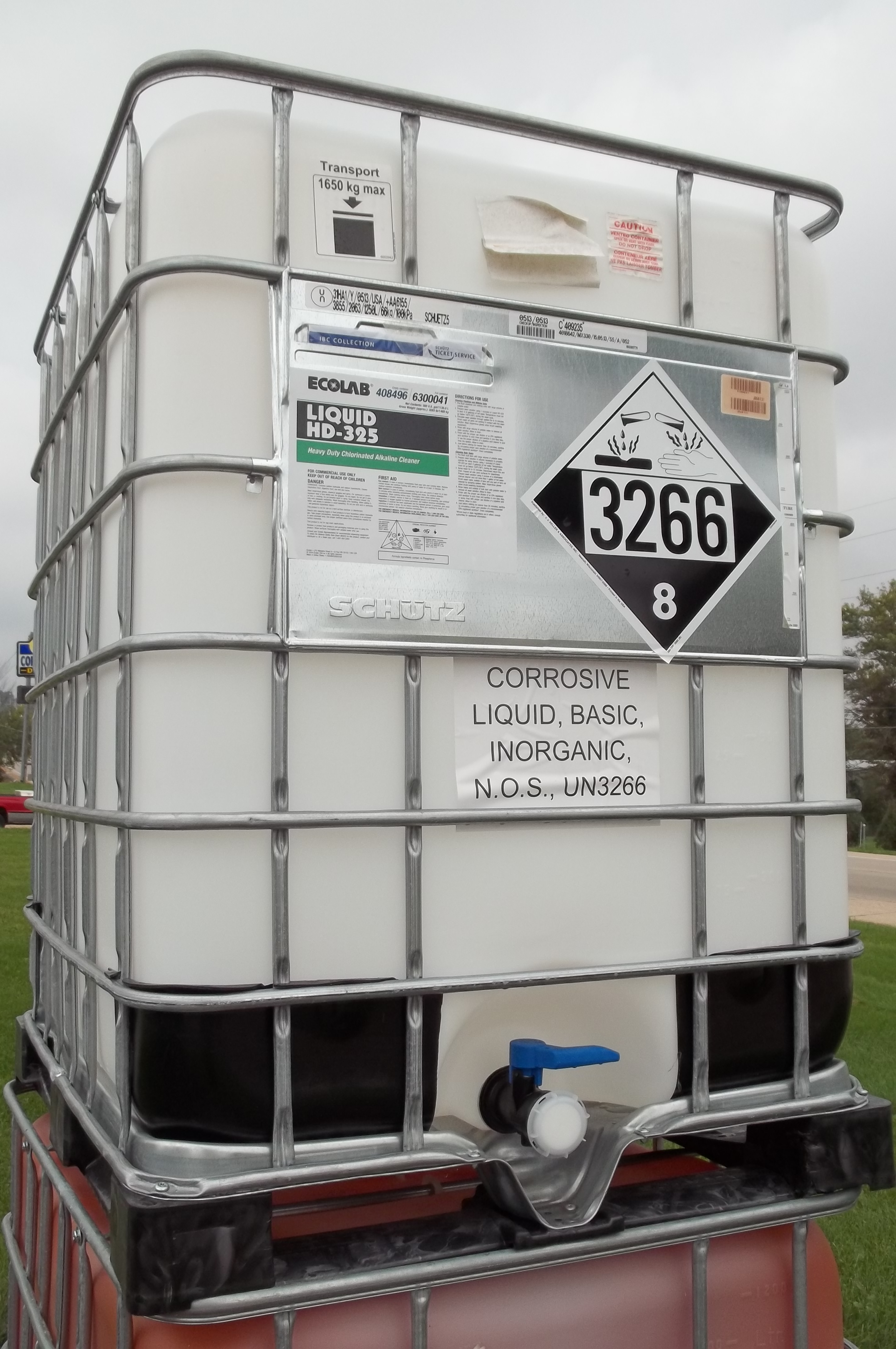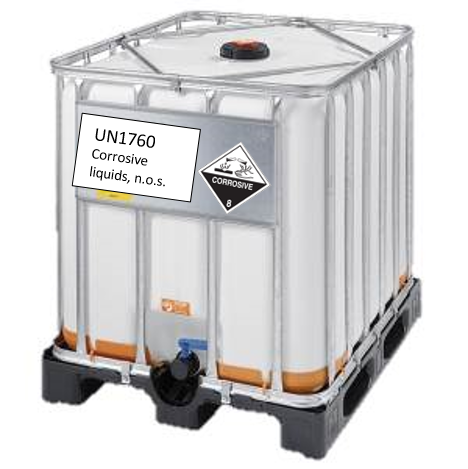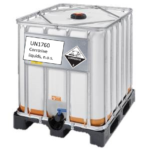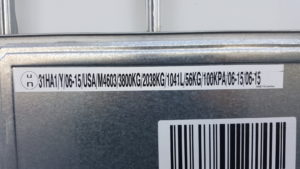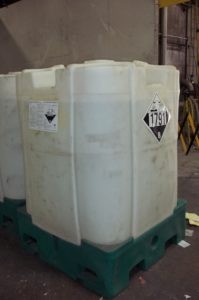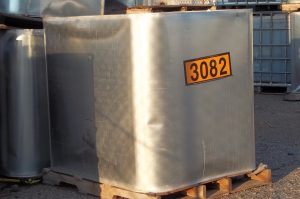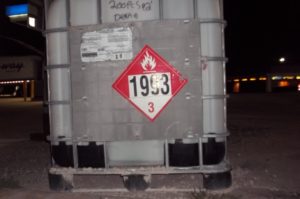If you prepare for transportation or transport hazardous materials in an Intermediate Bulk Container (IBC), you may be just as confused as I am (or was!) regarding the proper display of the required hazard communication methods. The answering of customer’s questions and the writing of this article forced me to look hard at the PHMSA/USDOT Hazardous Materials Regulations (HMR) and to arrive at an answer. Five of them, actually. In this article I will identify all of the options available to a shipper of HazMat in IBCs for the display of HazMat labels, markings, and placards. I will do this in three sections:
- Dispense some preliminary information necessary for complete understanding.
- Identify the applicable regulations and their meaning.
- Relying on the preliminary information and referring to the applicable regulations, identify five options for display of the required hazard communication methods on IBCs
At the bottom of this article I have embedded a Power Point presentation which summarizes the information presented and illustrates the five options explained herein. Please refer to it as a complement to this article and not a replacement for it.
Before we Begin:
An IBC is defined at 49 CFR 171.8:
Intermediate bulk container or IBC means a rigid or flexible portable packaging, other than a cylinder or portable tank, which is designed for mechanical handling. Standards for IBCs manufactured in the United States are set forth in subparts N and O of part 178 of this subchapter.
To sum up:
- An IBC can take many forms, “…rigid or flexible…”. It could be a plastic bladder in a metal cage mounted to a pallet. It could be a nylon or plastic sack. It could be a metal or plastic rigid packaging.
- It is not a cylinder for a compressed gas nor is it a portable tank, which is usually much bigger. Both of which are defined in §171.8.
- It is designed to be handled by mechanical equipment and not a person or persons. This eliminates most smaller packagings though the IBC is not specifically defined as a bulk packaging as is a cargo tank or portable tank. As a practical matter, every IBC I have ever encountered has been a bulk packaging. For the purposes of this article, we will assume an IBC to be a bulk packaging.
- Standards for IBCs are set forth in subparts N and O of 49 CFR 178. This differentiates an IBC from a large packaging or a flexible bulk container (standards set forth in subparts P/Q and R/S, respectively). This is important since these three different types of packagings may appear very similar.
The average volume of an IBC is 275 – 330 gallons. This is important because many of the requirements for HazMat labels, markings, and placards depend upon the volume of the bulk packaging or IBC.
[table “VolConv” not found /]
Read here: What is a bulk packaging?
A Summary of the Applicable Hazard Communication Regulations of 49 CFR 172
 Subpart D Marking:
Subpart D Marking:
- §172.301(a)(1): A non-bulk packaging must display the identification number and proper shipping name. There is no requirement to display this marking more than once. As of January 1, 2017 there is a minimum size requirement for the identification number marking on a non-bulk packaging.
- §172.302(a)(1): A bulk packaging with a capacity of ≥3,785 L (1,000 gallons) must display the identification number – not the proper shipping name – on all four sides.
- §172.302(a)(2): A bulk packaging with a capacity of <3,785 L (1,000 gallons) must display the identification number on two opposing sides.
- §172.336(d): A bulk packaging that displays HazMat labels instead of placards according to §172.514(c), may display the identification number in the same manner as a non-bulk packaging at §172.301(a)(1) instead of the identification number marking as it is normally required to be displayed on a bulk packaging.
- §172.332: When required on a bulk packaging, the identification number marking must be displayed with one of the following methods:
- On the placard.
- On an orange panel near the placard.
- On a white square-on-point configuration near the placard.
Subpart E Labeling:
- §172.400(a)(1): A non-bulk package must display the applicable HazMat label.
- §172.400(a)(2): A bulk packaging with a capacity of <18 m3 (640 ft3) must display the applicable HazMat label unless it is placarded according to subpart F. The requirement to label bulk packagings of this capacity does not apply to a cargo tank, portable tank, or tank car.
- §172.406(a)(1)(ii): HazMat label – if displayed – must be on the same surface of the package and near the proper shipping name marking.
- §172.406(a)(2): Except as provided in paragraph (e) of this section, use of more than one HazMat label on a package is not required.
- §172.406(e): Generally, only one of each different required label must be displayed on a package.
- §172.406(e)(6): Duplicate labels must be displayed on at least two sides of an IBC with a capacity of ≥1.8 m3 (64 ft3).
Subpart F Placarding:
- §172.504(a): Except as otherwise provided, a bulk packaging containing any hazardous material must display the applicable placard on all four sides.
- §172.514(c): An IBC may display placards on two opposing sides or it may display HazMat labels according to subpart E.
- §172.514(c)(4): An IBC displaying HazMat labels in accordance with subpart E may display the identification number in the same manner as a non-bulk packaging at §172.301(a)(1) instead of the identification number marking as it is normally required to be displayed on a bulk packaging.
Options for labeling, marking, and placarding Intermediate Bulk Containers
Option 1:
An option available to all bulk packagings – and the most burdensome – is to display placards and identification number on all four sides of the bulk packaging. The identification number must be displayed on or near the placard.
- Display placards on all four sides of a bulk packaging per §172.504(a).
- The display of the identification number marking on all fours sides is required for a bulk packaging of ≥1,000 gallons at §172.302(a)(1) and is an option for a bulk packaging with a capacity of <1,000 gallons.
- Display the identification number marking on or near the placard per §172.332 as for any bulk packaging.
Option 2:
A small revision to option 1 is to display placards on all four sides of the IBC and, if the capacity is below the threshold amount, to display the identification number marking on two opposing sides.
- Display placards on all four sides of a bulk packaging per §172.504(a).
- Display the identification number marking on two opposing sides per §172.302(a)(2) for a bulk packaging with a capacity of <1,000 gallons.
- Display the identification number marking on or near the placard per §172.332 as for any bulk packaging.
Option 3:
Both option 1 and 2 are available for most bulk packagings. With option 3 we arrive at one specifically designed to ease the regulatory burden for those who ship HazMat in IBCs. Option 3 allows for the display of placards on two opposing sides of the IBC along with the identification number marking if the capacity of the IBC is below the threshold amount.
- Display placards on two opposing sides of the IBC per §172.514(c).
- Display the identification number marking on two opposing sides per §172.302(a)(2) for a bulk packaging with a capacity of <1,000 gallons.
- Display the identification number marking on or near the placard per §172.332 as for any bulk packaging.
 Option 4:
Option 4:
Option 4 continues the progression of relaxing the regulatory responsibilities specifically for the use of IBCs as a packaging for HazMat. Option 4 allows for the display of HazMat labels on two opposing sides of an IBC with a capacity of ≥1.8 m3 (64 ft3). If taking advantage of this option the shipper may also display the proper shipping name and identification number marking near the HazMat label on one side of the IBC in the same manner as if it was a non-bulk packaging.
- For a bulk packaging with a capacity of <18 m3 (640 ft3), either display HazMat labels or placards according to subpart F per §172.400(a)(2).
- Display HazMat labels on the IBC as directed by subpart E per §172.514(c).
- According to §172.406(a)(2) and §172.406(e), display of more than one HazMat label on a package is not required.
- Display HazMat labels on two opposing sides of an IBC with a capacity of ≥1.8 m3 (64 ft3) per §172.406(e)(6).
- Display the proper shipping name and identification number marking in the same manner as a non-bulk packaging as is described at §172.301(a)(1) per §172.514(c)(4).
Option 5:
I saved the best option for last. A shipper of hazardous materials in an IBC may display a HazMat label on one side of an IBC with a capacity of <1.8 m3 (64 ft3). Remember: the capacity of a typical IBC is 275 – 330 gallons (330 gallons = 1.25 m3 = 44 ft3). If taking advantage of this option the shipper may also display the proper shipping name and identification number marking near the HazMat label on one side of the IBC in the same manner as if it was a non-bulk packaging.
- For a bulk packaging with a capacity of <18 m3 (640 ft3), either display HazMat labels or placards according to subpart F per §172.400(a)(2).
- Display HazMat labels on the IBC as directed by subpart E per §172.514(c).
- According to §172.406(a)(2) and §172.406(e), display of more than one HazMat label on a package is generally not required.
- Display HazMat labels on one side of an IBC with a capacity of <1.8 m3 (64 ft3) per §172.406(e)(6).
- Display the proper shipping name and identification number marking in the same manner as a non-bulk packaging as is described at §172.301(a)(1) per §172.514(c)(4).
Conclusion:
If you are uncertain about the option to display the proper shipping name and identification number marking on the IBC per §172.301(a)(1) as if it was a non-bulk packaging, so was I! Please refer to this PHMSA letter of interpretation issued in response to my query (LOI 15-0120) for confirmation that this option complies with the HMR. Please note the reference in the letter to §172.302(b)(2) isn’t an error. That particular citation was removed from the HMR during an update that took place after the date of the letter’s posting. It was replaced with §172.301(a)(1).
Here’s that Power Point embed I referred to at the beginning of this article. Remember, use it as an illustration to further explain the five options explained in this article.
That – I believe – is it. I’ve scoured the Hazardous Materials Regulations and cannot find any other options for the display of HazMat labels, markings, and placards on an Intermediate Bulk Container. Have you? Please let me know if you have, I’d love to add another option to this article. In truth, it’s option 5 that is the most important to shippers of hazardous materials in an IBC: no placards; no identification number marking on an orange panel, or on the placard, or on a white square-on-point; just a HazMat label and proper shipping name and identification number marking displayed on one side just as if it was a non-bulk packaging.
If you like this article, please share it using any of the social media platforms identified at the bottom of this article. You’ll look real smart recommending my articles! |
Interested in more information about shipping HazMat in IBCs?

